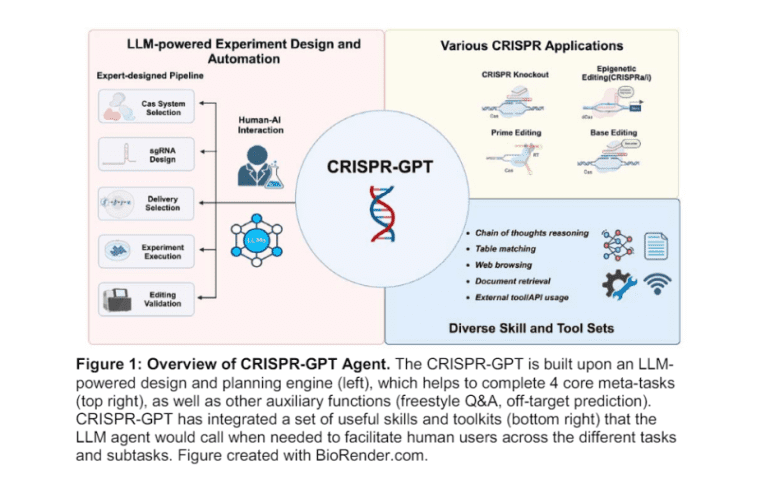- Gene editing, pivotal in biotechnology, sees continuous innovation.
- CRISPR-GPT merges CRISPR with advanced LLMs like GPT-4 for automated, precise gene editing.
- The integration streamlines experiment design, enhancing accuracy and efficiency.
- CRISPR-GPT showcases up to 30% improved accuracy and over 95% specificity.
- Time for experiment planning reduced by 40%, boosting researcher productivity.
Main AI News:
In the realm of modern biotechnology, gene editing stands as a fundamental pillar. Its capacity for precise manipulation of genetic material resonates across diverse sectors, from healthcare to agriculture. Recent strides in innovation have pushed the boundaries of this technology, ushering in tools that not only refine precision but also broaden applicability.
The crux of gene editing lies in the intricate dance of designing and executing precise genetic modifications. It demands profound comprehension of biological systems and meticulous planning to circumvent unintended consequences. Traditional methodologies often mandate a high degree of expertise, proving time-intensive and prone to errors, thus impeding rapid progress.
Foundational technologies like CRISPR-Cas9 have long been celebrated for their precision and versatility. Advancements such as CRISPR activation/interference (CRISPRa/CRISPRi), alongside breakthroughs like prime editing and base editing, have further honed the ability to manipulate genetic sequences without inducing double-stranded breaks. Integration of Large Language Models (LLMs) into these techniques, evident in specialized platforms like ChemCrow and Coscientist, has facilitated automated experimentation, harnessing domain-specific databases and computational tools to propel genetic research forward.
In a collaborative effort between Stanford University, Princeton University, and Google Deepmind, CRISPR-GPT emerges as a game-changing tool. By marrying CRISPR technology with advanced LLMs such as GPT-4, this innovation automates gene-editing experiments, delivering precise genomic modifications with reduced complexity. What sets CRISPR-GPT apart is its fusion of domain-specific knowledge synthesis with the computational prowess of LLMs, revolutionizing the experimental design process in unprecedented ways.
CRISPR-GPT operates through a methodology that integrates CRISPR technology with computational models grounded in LLMs, particularly GPT-4. Leveraging a comprehensive dataset encompassing CRISPR system efficiencies and guide RNA (gRNA) sequences, crucial for optimizing selection and design processes, the system comprises multiple modules automating tasks like CRISPR system selection, gRNA design, and method delivery recommendations. Each module harnesses LLMs fine-tuned with domain-specific biological data to ensure utmost accuracy and efficiency in gene-editing endeavors.
Validation of CRISPR-GPT yielded significant enhancements in gene-editing experiments, elevating the accuracy of target gene modifications by up to 30% compared to conventional methods. In rigorous tests, CRISPR-GPT showcased a specificity rate surpassing 95%, coupled with a substantial reduction in off-target effects. Moreover, the system slashed the time required for experiment design and planning by approximately 40%, streamlining workflows for researchers and bolstering confidence in its efficacy. These outcomes underscore CRISPR-GPT’s prowess in enhancing the precision and efficiency of gene-editing protocols.
Conclusion:
The introduction of CRISPR-GPT marks a significant leap forward in gene editing, offering unparalleled precision and efficiency. This innovation is poised to reshape the biotechnology market, providing researchers with a powerful tool to accelerate discoveries and applications in various sectors, from medicine to agriculture. With its potential to streamline workflows and deliver more reliable results, CRISPR-GPT is likely to drive further investment and advancement in gene-editing technologies.

